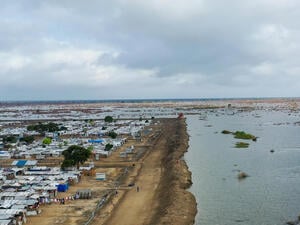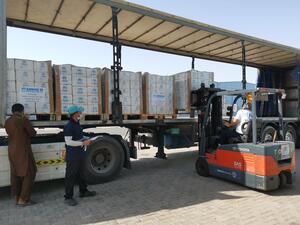Timber finally arrives on Indonesia's Nias Island to rebuild thousands of homes
Timber finally arrives on Indonesia's Nias Island to rebuild thousands of homes

Timber for rebuilding homes destroyed by last year's earthquake finally arrives at Gunung Sitoli harbour on Nias Island, Indonesia.
NIAS ISLAND, Indonesia, Mar 17 (UNHCR) - Reconstruction efforts on Nias Island received a boost this week when the first shipment of 2,000 cubic metres of timber arrived in the harbour of Gunung Sitoli. This is part of a huge rebuilding effort in which UNHCR will purchase 20,000 cubic metres of timber, enough to rebuild an estimated 5,000 new homes. A further shipment of 2,000 cubic metres is expected to arrive by the end of the month.
While still reeling from the Indian Ocean tsunami of December 2004, Nias Island - off Indonesia's Sumatran coast - was struck again three months later by an 8.7 magnitude earthquake that killed almost a thousand people and left thousands more homeless.
The powerful earthquake tilted the entire island. The south-eastern side of Nias fell by two metres - leaving a few villages half-submerged - while the south-western side rose higher above sea level. In some places the shoreline moved 200 metres inland.
The overall rebuilding project has been a joint effort with UNHCR's partners. At the request of Indonesia's Agency for Rehabilitation and Reconstruction (BRR), UNHCR is distributing the timber through some 14 national and international relief agencies who will help the people of Nias rebuild their homes. The World Food Programme sponsored the timber's shipping, while the Registered Engineers for Disaster Relief (RedR) Australia has provided technical experts to oversee the production and distribution of the timber. Once distributed, the end use of the timber will be monitored by the Association of Medical Doctors of Asia (AMDA).
One of the difficulties of this project so far has been finding sufficient quantities of legal timber.
"Obtaining sufficient quantities of legal timber has been one of the greatest stumbling blocks to reconstruction efforts moving ahead," said Gregory Garras, the head of UNHCR's office in Medan, the capital of North Sumatra province. But it was not the only one. "We were initially slowed down by unreliable timber suppliers who over-represented their capacities, and then some of our timber got caught up in the lengthy clearance process which is an aspect of the recent government crackdown on illegal logging."
Garras explained that UNHCR's policy was to support the Indonesian economy by buying all the timber for the project in-country.
"UNHCR has made it a top priority that all timber merchants it deals with must provide original documentation establishing that the timber they intend to supply has been legally sourced," he said.
As part of the project, UNHCR was given permission by the Nias authorities to build a large timber storage facility on disused land next to the jetty in Gunung Sitoli harbour. Once the project is completed it will be handed over to the local authorities as a contribution to the development of the port.









